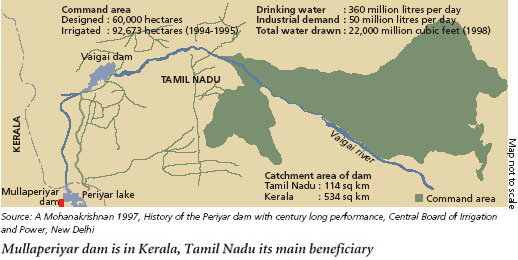Basics about Mullaperiyar Dam:
- The Mullaperiyar Dam is a masonry gravity dam on the Periyar River in the Indian state of Kerala
- The dam situated at the confluence of the Mullayar and Periyar rivers
- It is located 881 m (2,890 ft) above mean sea level, on the Cardamom Hills of the Western Ghats in Thekkady, Idukki District of Kerala, South India.
- It was constructed between 1887 and 1895 by John Pennycuick and also reached in an agreement to donate water eastwards to the Madras Presidency area (present-day Tamil Nadu).
- The Periyar National Park in Thekkady is located around the dam’s reservoir.
- The dam is located in Kerala on the river Periyar, but is operated and maintained by Tamil Nadu state.
- Dam was given to British-ruled Madras Presidency on a 999-year lease in 1886.
- The agreement was renewed in 1970.
- Tamil Nadu was given rights to the land and the water from the dam as well as the authority to develop hydro-power projects at the site, and Kerala would receive rent in return.
What is the controversy?
- For Tamil Nadu, the Mullaperiyar dam and the diverted Periyar waters act as a lifeline for Theni, Madurai, Sivaganga and Ramnad districts, providing water for irrigation and drinking, and also for generation of power in Lower Periyar Power Station.
- Tamil Nadu has insisted on exercising its unfettered rights to control the dam and its waters, based on the 1886 lease agreement.
- Kerala has pointed out the unfairness in the 1886 lease agreement and has challenged its validity.
- However, safety concerns posed by the 119-year-old dam to the safety of the people of Kerala in the event of a dam collapse, have been the focus of disputes from 2009 onwards.
- Kerala’s proposal for decommissioning the dam and constructing a new one has been challenged by Tamil Nadu.
- Idukki district, where the dam is located, is earthquake-prone and has experienced multiple low-intensity quakes. So, the dam is situated in a seismically active zone
- A 2009 report by IIT Roorkee stated that the dam “was likely to face damage if an earthquake of the magnitude of 6.5 on the Richter scale struck its vicinity when the water level is at 136 feet”
- It poses danger to life and property to people living downstream
- Three million people living in the vicinity of the reservoir.
Water lowering and Repairs:
- On the orders of the CWC, the Tamil Nadu government lowered the storage level from 152 feet to 142.2 feet then to 136 feet, conducted safety repairs and strengthened the dam
- It becomes difficult to sustain agriculture if water level is not increased
- One estimate states that “the crop losses to Tamil Nadu, because of the reduction in the height of the dam, between 1980 and 2005 is a whopping ₹ 40,000 crores.
What was 2006 judgment about the issue?
- On a suit filed by Tamil Nadu, the apex court in 2006 permitted the State to raise the water level from 136 ft to 142 ft.
- Within 15 days of the verdict, Kerala enacted a law and constituted Dam Safety Authority to prevent Tamil Nadu from raising the water level beyond 136 ft.
- In April 2006, Tamil Nadu filed a fresh suit to declare the law as unconstitutional.
SC 2014 Judgement
- The Supreme Court declared unconstitutional the law passed by Kerala in 2006, constituting the Dam Safety Authority to prevent the State from raising the water level in the Mullaperiyar dam from 136 ft to 142 ft.
- Judgement restrained Kerala from enforcing its law on Tamil Nadu.
- By enacting the law and fixing the storage height of the dam at 136 ft, Kerala had nullified the 2006 judgment and usurped judicial power and thus interfered with the judicial functioning.
- The Bench appointed a three-member committee with chairman of the Central Water Commission as the chairperson and representatives from the States of Kerala and Tamil Nadu to supervise and ensure that the water level in the Mullaperiyar dam was raised up to 142 ft.
Important observations about judgement:
- Constitution envisaged separation of powers among the Executive, Judiciary and Legislature and one should not encroach into the domain of the other. Independence of the judiciary and courts alone would ensure rule of law.
- Legislation could be invalidated on the ground that there was a breach of separation of powers in enacting the law, though the Legislature might have the competence to do so.
- The Legislature could only amend the law but could not invalidate a judgment or a decree passed by the court. The law enacted by Kerala legislature was an attempt to interfere with the judicial functioning, the Bench said and struck the law as unconstitutional and void.

thank you!!!!